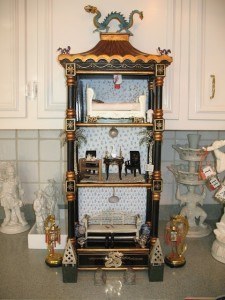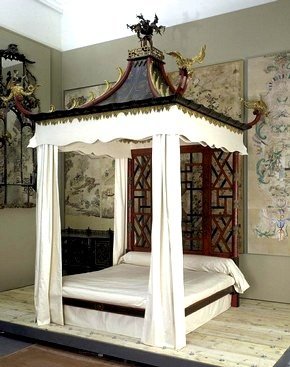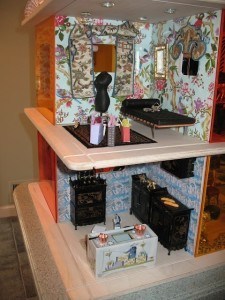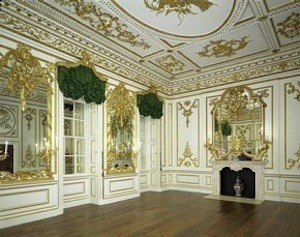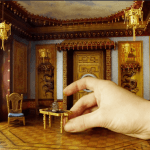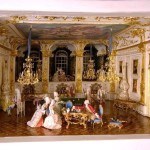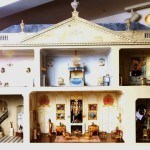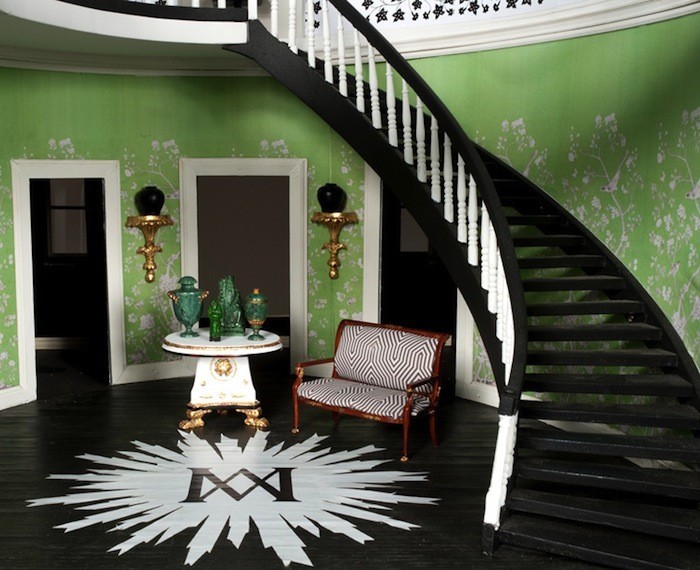
Mary MacDonald’s Dollhouse, found on A Lovely Being
History
This is a style inspired mainly by art and design from China and Japan. It is sometimes call “Regency Chinese” because of it’s identification with King George IV when he was Prince Regent during his father’s long decline into insanity.
Chinoiserie’s popularity grew with the rise in trade with the Far East. In the 18th century porcelain, imported silk and lacquerware were extremely fashionable. Whimsical and light in subject matter and appearance, chinoiserie provided an option to the more rigid classical styles that were prominent. This led many British designers and craftsmen to imitate Asian designs, and to create their own fanciful versions of Oriental art forms.
China seemed a mysterious, far-away place and chinoiserie drew on this exotic image. Objects featured fantastic landscapes with fanciful pavilions and fabulous birds, sometimes inspired by those depicted on actual Chinese objects. Dragons summed up all that was strange and wonderful about the East. Pagodas, with the sweeping lines of their roofs, were incorporated into a wide range of post-rococo objects, from gardens to bedrooms. The Badminton Bed is an example of it’s ubiquitous use.
The earliest appearance of a major chinoiserie interior scheme was at Versailles. The fad spread rapidly. No royal court in Europe was complete without its Chinese room, which was often reserved for the royal mistress. This may be the basis for chinoiseries being considered by many to be a feminine style.
Designers in the classical school hated chinoiserie, considering it “a style without form a structure, a retreat from reason and taste. A descent into a morally ambiguous world based on hedonism.”
The craze for chinoiserie gradually faded during the 19th century. The new exotica being Turkish, Egyptian and would you believe it … gothic and the ancient Greek.
Chinoiserie Design Elements
Chinese figures, emphasizing clothing
Fantastic landscapes
Dragons – more fanciful than video game fire-breathers
Mythical beast with an Asian flare
Pagodas – the up-turned eaves deflect evil spirits
Lacquer Finishes- black, orange-red, gold
Natural Settings – traditional Asian taken to bizarre extremes.
Rococo
Chinoiserie was closely related to the Rococo style, which was popular at the same time – 1730 to 1770. Asymmetry, scrolling forms and fantasy characterize both styles. They were often used together in interior decoration or even combined in a single object. Rococo takes its name from the French rocaille (pronounced ‘rock-eye’), which means the rock or broken shell motifs that often formed part of this style’s designs.
Rococo takes its name from the French rocaille (pronounced ‘rock-eye’), which means the rock or broken shell motifs that often formed part of this style’s designs.
Notable Miniatures
You won’t find many complete miniatures when you do an Internet search for “chinoiserie dollhouses miniatures.” The directory if hits will mainly be for wallpaper, furniture and accessories, but there a plenty real rooms to use as reference and inspiration.
You may find my articles on Baroque and Rococo styles helpful.
Susan Downing, with Patrick Owens


